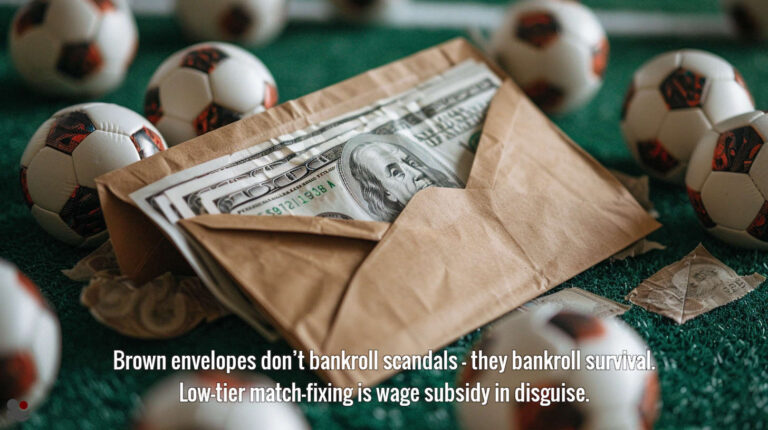
Fundamentals of Sports Betting (Betting on Over/Under ‘X’ Goals) is unlike any other book you will find elsewhere. It contains insights into how mathematics and statistics are applied to bookmaking, information that is rarely (if at all) found in the public domain.
Have you ever wondered how bookmakers set their odds? They must be pretty good at it to remain trading in a high risk industry built on small margins!
 Remember folks it’s all about finding the “edge”.
Remember folks it’s all about finding the “edge”.Image: Cartoonresource (Shutterstock)
It is common knowledge that the gambling industry as a whole relies to a large extent on the ignorance of its customers and, only by understanding how bookmakers think and act, will you ever be able to compete with them on a level playing field.
The Most Valuable Book About Betting You Will Ever Buy!
This course is designed to give you the essential, fundamental knowledge necessary to understand odds calculation and the bookmaker market.
It deals with relatively simple descriptive statistics and teaches you how to look at data sets, calculate your own probabilities and odds, analyse the market odds on offer, and make informed decisions when predicting football results.
Amongst the topics you will work through are distributions, deviations, graphs and charts, odds calculation, financial terminologies, risk management, and of course, how to identify ‘value’ in the betting market.
You will gain a deep understanding of the many different elements required to understand the bookmaker market and odds calculation. Many false beliefs that the majority of gamblers and fans of football have about betting will be exposed and stripped away.
Readers will also be enlightened to learn about how odds are set in the market, where to find ‘errors’ in market prices, how to evaluate data and graphs, and much, much more.
What Do You Get For The Money?
The course comes in electronic format and the bundle includes the course book (PDF*) and a Bundesliga cluster table (Excel) for studying. This course employs a didactic method of teaching, which is an educational technique. It is a very structured style of learning and as such, each section of the course should be mastered before moving on to the next.
To further encourage you to learn, there is a plethora of exercises to practice what you have learned, and the solutions to the exercises are found at the end of the book, sometimes embellished with further explanations.
All of the course lessons are presented in a pragmatic, easy-to-follow, step-by-step fashion, with no more than passing respect towards the sport of football and the passion of its fans. After all, this book has been written by a lady who loves maths but dislikes football…!
In addition, you will receive the very latest Bundesliga table for the current season, so that you can put into practice what you have learned and within the course, you will find a discount code enabling you to download for free the German Bundesliga sheet in future seasons, meaning that you will always have access to the most current Bundesliga cluster table, forever: it doesn’t matter when you bought the course.
*By the way, the PDF is a professionally formatted document and if you have a double-sided printer you can print your own book for studying.
Fundamentals of Sports Betting
Course with Cluster Tables for the German Bundesliga
Over/Under ‘X’ Goals
PRODUCT SUMMARY

- Format: PDF & XLS
- Download Size: Course (PDF): 5.2 MB & Excel file: 782 KB
- Publisher: Soccerwidow Ltd; 2nd Edition (July 2016)
- Pages: 169 (almost 38,000 words)
- Tables and graphs: 70
- Example tasks: more than 80 (with solutions)
- Language: ENGLISH
PDF document professionally styled for easy reading and printing
For traditionalists, the PDF has been professionally formatted for double-sided printing. If you like, you can print your book in full-colour with a cover and add slick spiral binding.
Those who prefer to read the document on their computers will find the chosen font (Myriad Pro) easy to read on the screen. Myriad Pro has a clean sans-serif aesthetic which makes it highly accessible.
The electronic version also contains a plethora of easy-to-navigate links to help the learner find his way around the document.
Contents at a Glance
Section A: Basic Knowledge
Probability, Betting Odds, Value, Yield, Profitability
Basic Statistical Terminology
- Goal Distribution and Percentage Calculation
- Deviation from the Mean
- Standard Deviation – The Main Measure of Variability
- Precision, Trueness and Accuracy
Betting Odds Calculation
- Probability and Betting Odds
- Opening Betting Odds Range
- Calculation of ‘Zero’ (Fair) Odds
Risk Management Control
- Financial Terms: Yield, ROI and Profitability
- Risk Forecasting and Evaluation: Value of a Trade (Bet)
- Preventative Measures: Setting the Starting Bank
Section B: Developing a Betting Strategy
Market Dynamics, Cluster Groups and Betting Tables
Market Dynamics
- Betting Odds are Prices of Bets
- Falling Odds represent Price Increase
- Bookmakers adjust Betting Odds to Public Opinions
Building of Cluster Groups
- What are Cluster Groups?
- Clustering Depending on ‘Strength’ of the Team
Betting Tables: Over/Under ‘X’ Goals
- Goal Distribution by Team
- Team Calculation Tables
- Standard Deviation Tables
- Using Calculation Tables to Determine Betting Odds
Finding Value Bets
- Everything that Glitters is not Gold
- Method I: Value Betting using Cluster Group Tables
- Method II: Value Betting using the Value Calculator
- Cluster Groups, Value Calculator and Bets Identification
…or ask any questions in the comment section below.









Hello
I am very interested in your book ‘Fundamental of Sports Betting – Over / Under X Goals’. I found that the updated edition is Jul-16. Just wondering if there is any new edition on the way? If so, I’d rather wait for the updated edition than buying the current one.
Also, will I receive any lifetime update whenever you refresh the ebook?
Lastly, any plan to release your ebook about 1×2 market?
Cheers
KC
Hi KC,
the maths and statistics in the book are absolutely time-less; it’s the examples that may seem a little bit outdated as it’s a 2016 edition. Otherwise, there isn’t anything outdated in the book.
Of course, in the future there will be an updated edition but certainly not before 2021; one update every five years is more than enough for a reference and course book.
Regarding giving lifetime updates… we offer them for the Bundesliga Cluster Table that accompanies the book but not for the course book itself. Sorry.
Here’s one of our latest client feedbacks if you have doubts if the course is for you:
Regarding an ebook about the 1×2 market… There won’t be a 1×2 ebook very soon. Things like books take ages to write. I’m sorry. Maybe next year but maybe even later.
However, there is a good number of articles about 1×2 system betting on Soccerwidow. That is the closest to a course that we can currently offer: https://www.soccerwidow.com/category/football-gambling/betting-knowledge/systems/1×2-betting/
Hi i bought the course but how do i get the discount code for the lifetime bundelisga cluster table.
Regards,
Colin
Hi Colin,
the code comes together with the product delivery but you’ll also find it in the course book, page 108 in the practice box.
Best wishes,
Soccerwidow
Hi Soccerwidow,
Nearly at the end of the course! Just stuck on question (D) of exercises 7.4 (page 130) where we put the value calculator into action.
For Hertha Berlin vs Stuttgart
I’m getting different results in my value calculator compared to the answers on page 151. I notice from the comments section that another of your students had similar issues but I wasn’t sure which was right.
For true odds using the value calculator for Hertha vs Stuttgart, I had:
0 – 0: 20.00
U 1.5: 3.49
U 2.5: 2.07
U 3.5: 1.49
U 4.5: 1.16
U 5.5: 1.01
U 6.5: 1.01
Not the same in the answers on page 151, which had
0 – 0: 23.98
U 1.5: 3.20
U 2.5: 2.00
U 3.5: 1.58
U 4.5: 1.19
U 5.5: 1.01
U 6.5: 1.01
What worries me is that I also got different results for Hannover vs Dortmund when I used the Value Calculator then (page 72). Since I want to try to use the value calculator as my main tool to detect value bets, I’m a bit worried I’m doing something fundamentally wrong. I don’t seem to get too much wrong when I do other parts of the course, by contrast. But I’m yet to get the same answers as the back of the book with the value calculator, despite diligently watching your excellent YouTube tutorials.
I can email you the spreadsheets or screenshots of them. Likewise, if you have other past examples of using the value calculator for specific matches, I could have a try at them and we could compare notes. Or if you plan on using the value calculator for any matches this weekend, I could have a try at those specific matches too.
I’d be most grateful for ANY assistance. Sorry for being a nuisance… again.
Kind regards,
Audiendi
Hi Audiendi,
this exercise in the course has unfortunately a bug. When putting together the examples I have for some reason missed one season what means that the 25 games that form the basis for the example calculations are incorrect.
Therefore, you have probably done everything right. I’m very sorry!
Just carry out the calculations with the figures shown on the screenshots in the course (the numbers for the last 25 respective games). Then, when you fully understand the calculations you can repeat the exercises with the correct data and from your provided example, you can already see that the ‘correct’ results only differ very slightly. That is why I haven’t worried about updating the course and rectifying that error.
The course is about understanding odds calculation, even if the example is ‘made up’ like it unfortunately happened in this one exercise.
The good news is that there aren’t any more errors in the course, at least none of which I’m aware.
Best wishes,
Soccerwidow
Hi Soccerwidow,
Just wondering for Chapter 7.2- Value Betting using Cluster Group Tables, I’m having a bit of trouble understanding the Cluster Groups.
I’ve opened the accompanying spreadsheet and gone to the Betting Tables tab. Taking Hannover at home, as an example. So, on page 120, there’s a copy of (part of) the table from the spreadsheet.
But what I don’t get is how we have separated Hannover’s 85 home games into four quartiles? And what’s the significance of each quartile?
So for example, with the first quartile. I’m at a loss to understand why the HO/AO range is from 0.000 to 0.604. Or why that first quartile is reflected by odds from 1.01 to 2.20.
I can sort of understand how, as Hannover is perceived as one of the weaker sides, it gets put in the bottom row (and it’s HO/AO quotient, against Dortmund, as 5.065 fits into that bottow row, between 1.1031 and 100.000). But I don’t understand why it’s those number specifically.
When I did the first thing on HO/AO quotient on page 105, I thought it made sense to me. But those clusters seemed to be based on bookmaker odds for specific matches between
team x and team y. Overall, I just can’t get my head around how the quartiles are arranged from 85 matches one team has played in, precisely what they signify and exactly what the quotient ranges and odds ranges refer to.
Sorry for such a long post from me which may have seemed a bit jumbled.
Kind regards,
Audiendi
Hi Audiendi,
The division of HO (Home Odds) by AO (AO Odds) reflects the “strength” of the teams perceived by the public. For example, if there is a match with “equally strong” teams, the HO/AO quotient is roughly between 0.8 and 1.2.
When building the quotient we’re not asking ourselves the question, “Are these teams really equal?” We do not calculate the 1×2 odds either, but simply use market prices and assume that the Bookmakers have reflected public opinion as well as possible.
Team ranking and public opinion is taken permanently into account in the 1×2 odds. That’s how bookmakers ensure that they stay in business and make their money!
‘Public Opinion’ for the 1,530 Bundesliga matches, seasons 2012-2017 (HO/AO quotients)
20%: 0.2918 The home team is the clear favourite with a very good chance of winning (much felt certainty for the outcome of the game)
40%: 0.5292 The home team is ‘definitely’ stronger than the away team, but there is also a good chance of a draw (opinion swinging between home or draw)
60%: 0.7830 The home team could win, but it could also be a draw or an away win (possible outcome is not really clear)
80%: 1,3172 The chances of a draw are pretty high; teams are felt to be equally strong (feeling is that both teams are evenly matched and the draw is probably the most likely outcome)
100%: 23,9400The home team is weaker than the away team; it ‘could be’ an away win(the favourite is the away team)
Take any Bundesliga weekend and cluster the matches according to the above HO/AO quotients (before kick off) and check against the distribution of results. You will see that they won’t distribute according to the implied probabilities of the AO/AO clusters.
There is a correlation between the HO/AO quotient and the O/U odds! I am currently expanding upon this whilst writing an update for the German version of the O/U course. Unfortunately, the explanation is not short and/or sweet enough to pack it into a comment. You’ll just have to believe me that the HO/AO quotient is a very important factor when judging if OU odds contain value or not.
Hi Soccerwidow,
OK. So, I calculate the HO/AO by dividing the 1 x 2 odds. Then I look at the cluster tables. I look at the the appropriate row (or quartile) of the table for, say, Hannover, to find out which odds correspond. And then I make sure it’s lower than the market odds and then do the same with Dortmund. That’s it?
But what I don’t understand is how to calculate the four quartiles of the HO/AO for each team, myself. What’s the process for separating the 85 previous matches into four quartiles? How does one build the cluster tables, oneself?
Cluster tables are crucial to a successful betting portfolio using the 5 seasons method, right? Let’s suppose I want to do this for Serie A. I’ll need to make a set of cluster tables, won’t I?
Kind regards,
Audiendi
Hi Audiendi,
you can unprotect the sheets (the passwords you’ll find in the legal tab) and then see how the formulas work and replicate them yourself for any league you like or, you can save yourself countless hours and simply buy the tables you’re interested in: https://www.soccerwidow.com/products/over-under-betting-cluster-tables/
Sorry Audiendi, this is a Betting course and not an Excel course. I’m not even going to try to explain advanced Excel formulas and how they work, and of course there are plenty of other websites dedicated to teaching Excel.
Hi Soccerwidow,
All good, all good. Sorry I’m sorry for being incredibly annoying. I’m such a stickler for trying to grasp all the finer details. I thought I had made a mistake by not knowing how to construct the cluster tables myself. So, the course doesn’t explicitly teach how to construct the cluster tables (in the way it teaches SD, RSD, %CV, expected losing streaks, etc.)?
I’d just buy the cluster tables, sooner than trying to replicate them. Much easier.
So, basically to put the five seasons method into practice, it’s necessary either to buy the relevant cluster sheets (or to replicate them)?
Kind regards,
Audiendi
Hi Audiendi,
this course is designed to introduce readers to the essential, fundamental knowledge necessary to understand odds calculation and the bookmaker market. The intention of the course is to introduce the subject of odds calculation to punters. It is therefore not a “five season method”; it teaches distributions, graphs, financial terminology, etc… all with the goal to show the reader how professionals (such as bookmakers) approach setting their odds.
Please look at the image above… to put the course into perspective… The course is an ‘introduction’ and if there would be ‘betting degrees’ at universities then students would learn the contents in the Bachelor Year 1.
Therefore, please work fully through the course first, until you understand absolutely everything. Then try your knowledge on the Bundesliga. If you feel that you would like to learn more, then consider purchasing the EPL as it is a much more liquid league on the exchanges.
To summarise, you must thoroughly understand the fundamentals before mastering odds calculation, and I’m afraid that like everything worth having in life it will take time to accomplish.
Hi Soccerwidow,
Me again, sorry. I wondering if there’s a mistake in the book or if I’ve miscalculated somewhere. It’s only a small difference, but I wanted to be sure I’m on the right track.
On page 89, for (G) (i) we have to calculate the probability of winning a bet for ‘Over 2.5 Goals’ using the Five Seasons Method compared to the Value Calculator Method. You’ve provided Zero Odds for both. Zero Odds for the Five Seasons Methods are 1.60. While Zero Odds for the Value Calculator method are 1.43.
So, to calculate the probabilities, I went…
Five seasons. Probability = 1 divided by betting odds
= 1 / 1.60
= 0.625
= 62.50%
Value Calculator. Probability = 1 divided by betting odds
= 1 / 1.43
= 0.6993
=69.93%
But in the answers (on page 146), it says the respective probabilities are…
Five seasons method: 62.36%
Value Calculator method: 69.89%.
Have I made a mistake somewhere?
Kind regards,
Audiendi
Hi Audiend,
Please remember how to calculate ‘Zero’ odds…
(1) Calculate the probability
(2) Convert the probability in odds
Not the other way round!
Five seasons method expected ‘Zero’ probability: 62.36%
1 divided by 0.6236 = 1.603592046 (rounded: 1.60)
Value Calculator method expected ‘Zero’ probability: 69.89%.
1 divided by 0.6989 = 1.43081986 (rounded: 1.43)
Hi Soccerwidow,
Thanks for that. I understand where I went wrong. All that was written, in the question, I’d forgotten that we’d already carried those calculations earlier. And it makes sense how a statistical probability is a more precise representation than the betting odds. As such, I understand what you mean by the idea of calculating the probability first and, then, converting it into odds.
Kind regards,
Audiendi